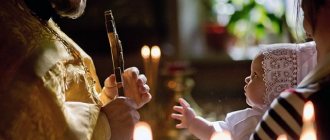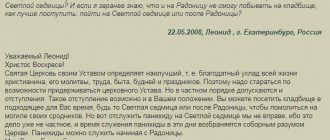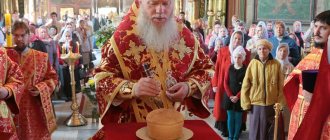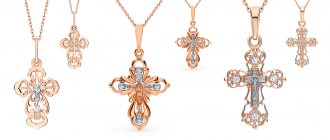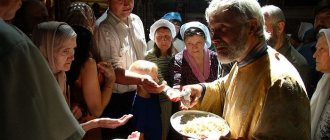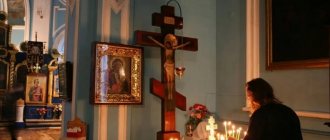In this article, we will look at the answer to a frequently asked question by people, especially non-religious people, how long has a church been in business. But before you start, keep in mind that all temples open and close at different times.
In the article you will find answers to questions about the Christian faith, tips and recommendations.
Temple and Cathedral
Please note that churches and cathedrals open at different times depending on
First of all, large city cathedrals often open early and close later than others. The difference between a temple, a church and a cathedral is as follows:
The concept of “temple” means the seat of God, the house of God - that is, a building. Also in the books of the Apostolic Epistles and the works of the Holy Fathers, the human body is called the temple of God, because God’s grace and the Holy Spirit dwell in a believing and pious person who approaches the Sacraments of the Church.
The concept of “Church” is quite broad: it is a building (in this meaning of the word church and temple are one and the same!), and a meeting of all believers, and a regional meeting of Orthodox people - for example, the Russian Orthodox Church, the Greek Orthodox Church.
A cathedral was originally the main temple of a city or monastery. Nowadays such a cathedral is called “cathedral”, and the word “cathedral” simply means a large temple. That is, prominent large temples in cities will be called cathedrals. Also, the Old Russian word “cathedral”, translated as “assembly”, still refers to congresses of the episcopate and lay Christians to this day (for example, the Ecumenical Council is a meeting of representatives of all Orthodox regional Churches, the Local Council is a meeting of one Church).
Types of services
Regardless of who holds it and in what place, all services are divided into daily, annual and weekly. Full services are held in monasteries, and it is the monks who follow all the canons of the church. The monks fully comply with the rules of church services, but in small churches they are held depending on the schedule created by the ministers.
Each day of the week is celebrated in the church and dedicated to certain moments:
- Sunday is Little Easter, on this day the resurrection of Christ is remembered.
- You can pray to the angels on Monday.
- John the Baptist hears prayers on Tuesday.
- On Wednesday they remember the betrayal of Judas and the memory of the Cross.
- Thursday is considered an apostolic day and is dedicated to St. Nicholas.
- On Friday, services are held dedicated to prayer for the suffering of Christ.
- Saturday is dedicated to the Mother of God.
Therefore, if you do not have the opportunity to go to church regularly, then you can read prayers every day, depending on who they will be intended for.
What time does the temple close?
After the evening service or according to a schedule that needs to be confirmed with the staff.
Solemn evening services - All-night vigils - are held before church holidays, days of revered saints and on Saturday. The name is just a tradition; the service does not last all night, but for about 2-3 hours in different churches.
The all-night vigil begins either at 17:00 or 18:00. Sometimes - in rare cases, in a village, in a remote monastery - at 16:00.
In monasteries, services for both the Liturgy and the All-Night Vigil last longer.
Rules for visiting Church
The duty of every true Christian is to attend Church, especially on Sundays and holidays, and to participate in the Liturgy. A parishioner must know 12 simple rules for visiting Church and teach these rules to younger family members: 1. Find out in advance what time the service begins in the Temple, and try to come to the Temple fifteen minutes before the start. If you are late, be careful not to disturb the prayers of others. 2. Men must remove their hats before entering the Temple. “Therefore, a husband should not cover his head, because he is the image and glory of God; and the wife is the glory of the husband.” (IKop 11:7) 3. Women must enter the Temple with their heads covered. “And every woman who prays or prophesies with her head uncovered disgraces her own head” (IK 11:5). “Therefore a woman should have on her head a sign of authority over her, for the Angels” (IKop.l 1:10). All holy women and the Virgin Mary herself are depicted on icons with their heads covered. 4. Mobile phones should be turned off before entering the Temple. 5. Women should know that they should enter the Church with modest, discreet makeup on their face (preferably without it at all). It is unacceptable to venerate sacred objects with painted lips. 6. Clothes should be modest (it is unacceptable to wear shorts, miniskirts, deep necklines, etc. provocative clothing) and neat. 7. If you come to the Temple during the Divine Service, it is better to refrain from squeezing through the worshipers behind the candles. During the Liturgy, when Christ Himself sacrifices Himself for us on the altar, turning your back to Him and buying candles at this time is simply not Christian. If you want to light a candle, come before the service starts. It is sad to see how those who came to the temple in the middle of the service, late, at the most important and solemn moments of the Divine service, when everything freezes in thanksgiving to God, violate the decorum in the temple, buying their own candles, distracting other believers. If anyone comes to church during the Liturgy, let him wait until the end of the service, and then, if he has such a desire, light a candle without distracting others or disturbing decorum. 8. Parents, having come to the Temple with their children, must strictly monitor their behavior, not allow them to distract the worshipers in any way, otherwise it is better to take them out into the street. 9. People who smoke are prohibited from smoking even in the Church yard. 10. According to the church charter, women during menstruation are excommunicated from all sacraments of the Church; touching icons and shrines is also prohibited. However, you can go into the Temple and confess. 11. Do not keep your hands behind your back or in your pockets. Do not cross them on your chest. While sitting, do not cross your legs. 12. When leaving the Church, you should turn to the altar and cross yourself.
If the church is closed
Sometimes, especially in the provinces, churches are closed most of the time. This is due to the fact that priests and church employees live on donations and part-time jobs (for example, in villages, priests earn extra money as drivers, loaders, and tractor drivers), so they often come only to worship services.
Usually the phone number of the church or priest is either on the wall, or on the website, or in the office of the diocese. Do not hesitate to call the priest if you have a difficult question or need to be baptized, married, or have a funeral service for a loved one.
It also happens that the temple is closed all the time and the priest comes from the city on certain days or the temple is undergoing repairs. If there is no information about this on the stands near the church, call the diocese office.
Exceptional case
Many provincial churches are closed most of the time, and services are not held every day.
In this case, you should contact the abbot. Contact us in the following cases:
- wedding;
- baptism;
- funeral service;
- confession.
If the priest has everything to perform divine services and the opportunity, then the temple will be open.
When is the best time to go to temple?
Many people who don’t yet know much about the Church get used to being “goers” - coming in when it’s convenient, lighting candles and not praying during services. However, the Lord Himself speaks about church prayer during general worship: “Where two or three are gathered in My name, there I am in the midst of them.” The original meaning of the word “Church” is a meeting of Christ’s disciples, Christians; translated as “meeting”. It is interesting that the first Christians often gathered not only in buildings; it is important that they were together even in the open air and could perform the Sacraments and pray.
The main service in the church, the main sacrament, is the Liturgy. The most powerful prayer is any commemoration of a person during the Liturgy and, of course, communion itself. The whole Church prays for a person during the Sacrament of the Eucharist.
After the words of Christ: “Take and eat: this is My Body and My Blood,” - by the grace of the Savior, bread and wine, having their former appearance, then ceased and cease now at every Liturgy to be earthly things. They become, according to the Gospel word, bread, that is, the food of life - the Flesh of Christ, which He gives for the forgiveness of all human sins. By receiving communion, people receive great strength and grace from God.
The Church blesses us to receive communion at least once a year: preferably about once a month.
Why can the temple be closed permanently?
It happens that no one serves in the church. With what it can be connected? Of course, with the absence of a priest. It is possible that the Diocesan Council is deciding where to find the priest. Another reason is the lack of infrastructure inside the church (lack of an iconostasis, dangerous condition of the building, and so on). Of course, there is no point in asking when the church opens and until what time the church is open in this case.
Well, you and I have considered the issue of the operating hours of Orthodox churches. Unfortunately, there cannot be a single answer to the question posed. After all, each priest sets his own schedule.
Sources:
https://kazanskii-hram.church.ua/2017/04/04/kogda-i-kak-delat-poklony-ustav-o-poklonax/ https://www.bcex.ru/v-kakie-dni- iv-kakoe-vremya-luchshe-poseshhat-xram https://fb.ru/article/258353/so-skolki-i-do-skolki-rabotaet-tserkov-pravoslavnaya
How to behave correctly in the temple
Upon entering the temple, you will see in front of the icons special gilded candlesticks for many thin candles and several thick ones. They are located in front of most icons, as well as near the icon lying in the center of the temple on a separate inclined table - a lectern (this will be an icon of a saint or an event whose memory is celebrated on this day, or an icon of the Resurrection of Christ).
Most often, candles are first purchased from a church store. The first candle is placed on the central candlestick in the temple, saying to oneself: “Lord, bless! Most Holy Theotokos, save us!” After setting the candles, they cross themselves and bow to the altar.
They also place candles in front of any icons, the saints depicted on which you want to pray.
Approach your chosen icon at any distance. Cross yourself, say: “Bless, Lord (or – Mother of God, or – saint...).”
Tilt it towards a lamp or, better yet, (lamps have short wicks and can go out on contact) towards someone else’s candle, light it from the fire. Try not to drip wax into the lamp.
Bring the other end of the candle to the fire to soften the wax and immediately place the candle in the chosen place on the candlestick.
Cross yourself again, looking at the icon, and bow.
Now you can read the prepared prayer or pray in front of the image in your own words. Read the prayer with attention, remain in communion with God, the Mother of God or the saints, address them as if they were alive. Tell us in your own words about trouble and sorrow, ask for help.
After prayer, you can kiss the icon according to tradition - this is called “kissing the icon”: cross yourself twice, kiss the hand or the edge of the clothing of the image on the icon, cross yourself again.
It is better not to light candles during services. Look at the situation, get baptized together with other people, bow down. In the temple, no one will especially watch you.
When and how to bow. Regulations on bowing
Often in a church you see a picture when particularly zealous parishioners, who have obviously recently joined the church, but have not bothered to find out the rules of the Church regarding when and how it is appropriate to bow and other necessary actions during the service, begin to cross themselves and fall to their knees inappropriately.
To tell the truth, I myself was like that quite recently. And they probably looked at me just as strangely in the temple. After all, making bows on those days or moments of the service when they are not supposed to be done is called “disorderly conduct” and testifies not to ardent faith, but to an unwillingness to learn the simplest rules of behavior in the temple. But according to Christ, “he who is faithful in a little is also faithful in much, and he who is unfaithful in a little is also unfaithful in much” (Luke 16:10).
So, in order to avoid getting into awkward situations, you need to know the Rules on Bowing. Yes, yes, bows, like any other part of worship (both temple and cell) are regulated in the Typikon - the book of Rules, so that no one does it as he pleases. In addition to bowing, the same document describes when one should and should not cross oneself, kneel, and much more. This order is needed so that there is uniformity in the service, so that none of the parishioners tries to exalt themselves with pride, showing special zeal, and also so that bows and imposition of the sign of the cross are not done when this is completely inappropriate in meaning services.
What time does it open, until what time is the Church of the Matrona of Moscow open?
One of the most revered Russian saints is Matrona of Moscow. Matronushka, blessed Matrona, Saint Matrona of Moscow - all these are the names of one saint, revered by the entire Orthodox Church, beloved and dear to Orthodox Christians around the world. The saint was born in the 19th century and died in 1952. There are many witnesses to her holiness who saw Matronushka during her lifetime. Even today she helps those who pray; there are many testimonies about miracles after prayers in front of her icons and relics and about the appearances of the blessed Matrona in dreams to believers.
There is a pious Orthodox tradition of writing notes to Saint Matrona - like personal letters. It is known that there are prayers to the Matrona of Moscow, and simply in your own words you can ask Matronushka for help. However, according to tradition, you can write notes, examples of which you will see, and put them behind the icon in the temple or to the relics of the saint.
There is a tradition of praying for help to the Matrona of Moscow at her relics in the Pokrovsky Monastery at the Pokrovskaya (Abelmanovskaya) outpost in Moscow. This place is also known as the temple or monastery of the Matrona of Moscow on Taganka.
The relics and the monastery are open from 8:00 to 20:00 at the address: Moscow, st. Taganskaya 58. You can get to the monastery by ground transport or by metro.
It is known that there are reference sites about Saint Matrona, but the notes and comments on the Internet are not true letters from the saint. A visit to the temple or the Intercession Monastery, where the relics of Matrona reside, will become your pilgrimage, a small labor as a sign of your desire to be heard.
There is a tradition of going to Matronushka for help with flowers - a living offering to her, evidence of the sincerity of your prayer and love for the saint. You will definitely feel that Matrona of Moscow becomes like family to you, as for many people - that’s why she is affectionately called Matronushka. In the Pokrovsky Monastery there are always many bouquets of fresh flowers around the shrine (tomb) with the holy relics of the blessed one. Often priests give their blessing to take flowers laid by other people who are seriously suffering and ill as a gift from the Matrona of Moscow herself.
If possible, purchase an odd number of roses - the saint loved them during her lifetime - place them near the image or at the relics.
Buy church candles and before the image of the blessed one in the temple, read the prayer according to the text below. Talk to her as if she were alive - that’s what she asked herself.
May the Lord bless you with His grace!
Source
On what days and at what time is it better to visit the temple?
Of course, it is impossible to give a definite answer to this question. It all depends on what purpose you came there for. Many people like to visit an empty church when there is no service. Why? Someone is looking for solitude in the temple, an opportunity in a quiet, calm atmosphere to think about God, about eternal, enduring values, about their soul, life, to ask for help, admonition, or simply to pray.
Another, on the contrary, is more attracted by the divine service: beautiful singing, splendor in the performance of sacred rites, temple architecture, icons, the characteristic aroma of incense mixed with incense smoke characteristic of the church. Some people don’t choose a special time: they came in when the need arose, or just when it happened. Someone needs the advice of a priest. There are also those who come simply out of curiosity.
